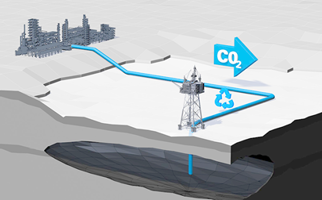
The Oil and Gas Authority’s (OGA) has for the first time expanded its benchmarking to the flaring and venting of greenhouse gases on the UK Continental Shelf (UKCS) - detailing flaring and venting activity levels in the North Sea and the resulting contribution to UK oil and gas greenhouse gas emissions.
The volume of gas flared and vented in offshore upstream oil and gas production last year was equivalent to 3% of all the natural gas produced in 2019. While some venting, which is discharging gases to the atmosphere, and flaring, which is burning gases before they are discharged, is unavoidable for safety and operational reasons, more can be done to reduce this number.
The OGA issues consents for flaring and venting of gas on extant licences and is exploring tougher measures as part of this process, to eliminate unnecessary or wasteful flaring and venting. As part of the OGA’s commitment to integrating net zero considerations into its work, it is aiming to closely scrutinise operator flaring and venting requests – in both existing production and in new field development plans. The OGA has also now introduced benchmarking of flaring and venting data in order to drive improved performance across industry.
While the report acknowledges inconsistencies in assessment standards and calculation methods, recognising this as a key area of work going forward, findings of the report include:
- 42 billion standard cubic feet of gas (bcf) was flared in 2019 from offshore facilities.
- However, the volume of gas flared in 2019 was a 4% reduction from 2018, the first annual reduction since 2014.
- 0.7 bcf of gas was vented on the UKCS in 2019 from offshore facilities. This was a 34% reduction from 2018.
- In 2019, on the UKCS 114 standard cubic feet of gas was flared for every barrel of oil produced (scf/bbl). This measure has fallen for two consecutive years and is 12% down from 129 scf/bbl recorded in 2017.
Good practice already being shown by industry includes some operators looking at eductors – specialist pumps - to minimise flaring, and evidence that many are prioritising flare/vent volumes as a key performance measure in their day-to-day operations.
Currently flaring alone makes up a quarter of all UK offshore oil and gas production related carbon dioxide (CO2) emissions and represents 1% of total UK annual CO2 emissions (2019)1.
Venting produces less than 1% of UK offshore oil and gas CO2 emissions, but is responsible for around half of all offshore methane emissions. This represents 1% of total UK annual methane emissions (2018)2.
Hedvig Ljungerud, OGA Director of Strategy, said:
“The OGA is looking to take a robust stance on flaring and venting - through its consents, field development process and project stewardship. While it’s encouraging to see a fall in volumes flared and vented, we believe there are clear opportunities for industry to go further to advance cleaner production.
“Our benchmarking has already been proven to raise performance levels in other areas, such as production and decommissioning cost efficiency, enabling operators to learn from good examples set by others and allowing us to focus our attention and interventions in the right areas.”
ENDS
1 2019 UK greenhouse gas emissions, provisional figures
2https://naei.beis.gov.uk/overview/pollutants?pollutant_id=3
Notes to Editors
- Flaring and Venting benchmarking report
- Strategy Review
- Energy Integration Report
- For more information go to oga.pressoffice@nstauthority.co.uk


